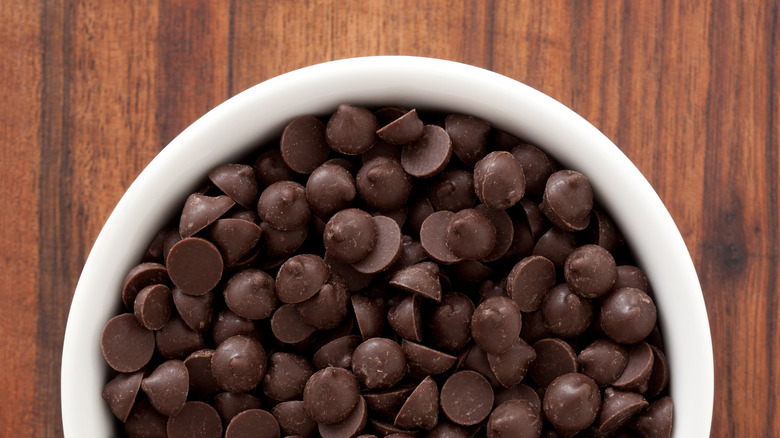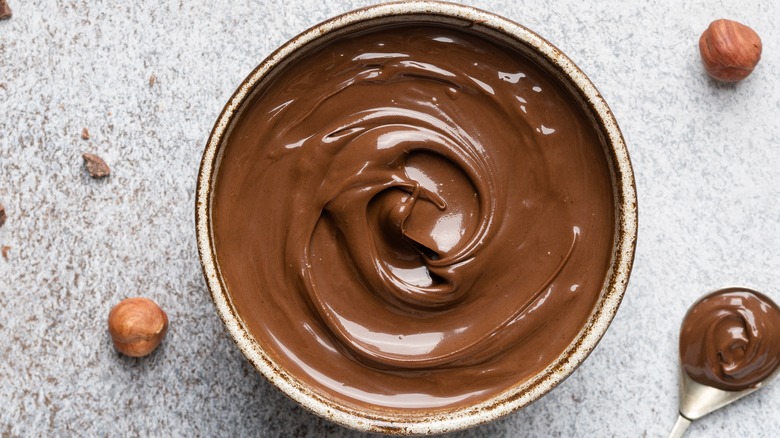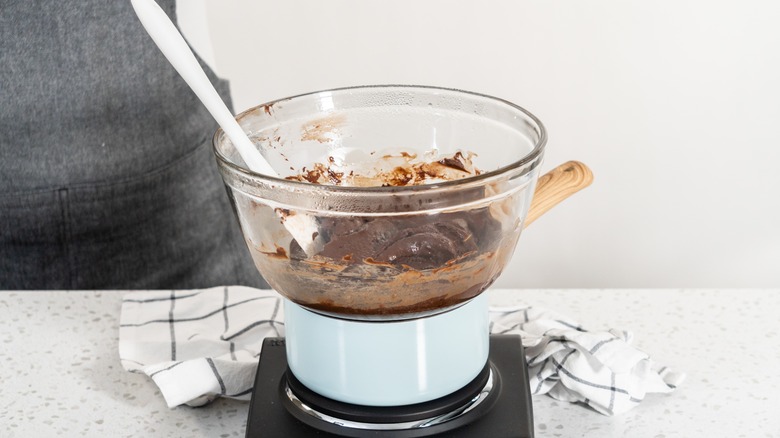Why You Really Shouldn't Be Using Chocolate Chips For Melting
Melting chocolate is essential in crafting chocolate-covered strawberries, nuts, pretzels, and marshmallows. It can also be drizzled on top of popcorn for a sweet-and-salty snack or transformed into a craggy bark with bits of candy and other ingredients sprinkled on or mixed in. However you choose to use it, heating the solid sweet can help turn it into something even tastier, but it's important to use the right stuff. Blocks or bars of chocolate are specifically designed to be melted down and used for other purposes. Some recipes that call for the bars recommend using a knife to cut the chocolate. Swapping these bulkier blocks for some chocolate chips may seem like it'll save you a step since they're already pretty small. However, not all chocolate is created equally; chips are prone to major melting mishaps.
For one thing, as Dr. Emma Davies points out in BBC Science Focus, a chocolate's cocoa butter content affects its ability to melt; chocolate chips generally contain less of this essential component, which increases the melting point and makes the process trickier. More importantly, chocolate chips also often contain stabilizers that make them a poor choice for melting. These stabilizers can create an uneven texture in the melted chocolate.
The chips melt with an uneven consistency
The most common stabilizer found in chocolate chips is soy lecithin. While warm, gooey chocolate chip cookies fresh out of the oven might be a little bit melty, this food additive prevents those morsels from melting completely and helps them stay intact even after a go in the oven. While this might be beneficial for mixing into your baked goods and creating picture-perfect cookies, those chips won't melt down nicely.
Even if they can be heated enough to lose that rigid shape without being burned, the results won't be the same as you would achieve with baking chocolate. Instead, the melted chocolate may have a lumpy, denser consistency. This can make it harder to work with when mixing and could create some imperfect visuals for your finished desserts.
For example, if you're creating a chocolate ganache to top off your cakes, you'll likely want it to look as smooth as possible. The uneven texture of the melted chocolate chips could create some strange lumps in the spread, and it might potentially become grainy, making it a little more challenging to work with in the first place.
Tips for if you have to use chocolate chips
If chips are the only type of chocolate you have on hand, they can be used in a pinch. Although you can melt them in the microwave, making a double boiler on the stovetop is the preferred method when you want to perfectly melt chocolate without burning it. This will allow you to keep a closer eye on them as they melt down, ensuring they don't burn. Allow a pot of water to come to a boil on the stovetop, then carefully place a heat-safe bowl on top. Pour the chocolate chips in, and use a whisk to mix them around. The stirring motion helps evenly distribute the heat throughout the bowl, preventing the melted chocolate chips from scorching.
To combat the thickness caused by the stabilizer in the chips, you can add a splash of vegetable oil or shavings of cocoa butter to thin the melted mixture out a little bit. Melting chocolate chips can work if you don't have any bar chocolate available, but if you're seeking the smoothest results, it's worth it to grab a block and chop it up yourself.


